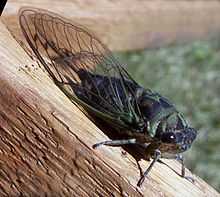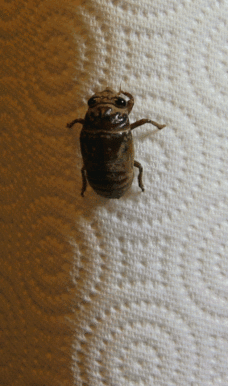Tibicen
| Tibicen | |
|---|---|
 | |
| Linne's cicada (Tibicen linnei) | |
| | |
| Calling song of Tibicen chiricahua | |
| Scientific classification | |
| Kingdom: | Animalia |
| Phylum: | Arthropoda |
| Class: | Insecta |
| Order: | Hemiptera |
| Family: | Cicadidae |
| Subfamily: | Tibiceninae |
| Genus: | Tibicen Latreille, 1825 |
The genus Tibicen comprises large-bodied Cicadidae appearing in late summer or autumn.[1] Many colloquial names exist for Tibicen, including locust, dog-day cicada, harvest fly, August dry bird, jar fly, bush cicada, and dry weather fly.
Tibicen species are the most common cicada in the United States. Unlike periodical cicadas, whose swarms occur at 13- or 17-year intervals, Tibicen species can be seen every year, hence their nickname "annual cicadas". The life-cycle of an individual, however, is more than a year. Nymphs spend two or three years feeding on tree roots before they emerge. Their annual reappearance is due to overlapping generations.
Tibicen cicadas are 1–2 inches (25–51 mm) long, with characteristic green, brown, and black markings on the top of the thorax, and tented, membranous wings extending past the abdomen. The fore pair are about twice the length of the hind pair. Adults feed using their beak to tap into the xylem of plants; nymphs feed from the xylem of roots.
Communication
Like other members of the subfamily Cicadinae, Tibicens species have loud, complex songs, even (in many cases) distinct song phrases.[2]
Males produce loud calls in the afternoon or evening (depending on the species) to attract females. These sounds, distinctive for each species, are produced by organs below the abdomen's base. These calls range from a loud buzz to a long rattling sound.
North American species
- Tibicen auletes Germar, 1834 – Northern dusk singing cicada
- Tibicen auriferus Say, 1825 – Field cicada
- Tibicen bermudianus Verrill, 1902 – Bermuda cicada, EXTINCT (Last seen 1994)
- Tibicen bihamatus Motschulsky, 1861
- Tibicen bifidus Davis, 1916
- Tibicen canicularis Harris, 1841 – Dog-day harvestfly
- Tibicen chiricahua Davis, 1923
- Tibicen chisosensis Davis, 1934
- Tibicen cultriformis Davis, 1915 – Southwestern giant floodplain cicada
- Tibicen davisi Smith and Grossbeck, 1907 – Davis's southeastern dog-day cicada
- Tibicen dealbatus Davis, 1915 – Plains cicada
- Tibicen dorsatus Say, 1825 – Bush cicada
- Tibicen duryi Davis, 1917
- Tibicen figuratus Walker, 1858 – Fall Southeastern dog-day cicada
- Tibicen hidalgoensis Davis, 1941
- Tibicen inauditus Davis, 1917
- Tibicen latifasciatus Davis, 1915 – Coastal scissor grinder cicada
- Tibicen linnei Smith and Grossbeck, 1907 – Linne's cicada
- Tibicen longioperculus Davis, 1926
- Tibicen lyricen De Geer, 1773 – Lyric cicada
- Tibicen minor Davis, 1934
- Tibicen montezuma Distant, 1881
- Tibicen neomexicensis Stucky, 2013
- Tibicen ochreoptera Townsend, 1892
- Tibicen parallelus Davis, 1923
- Tibicen paralloides Davis, 1934
- Tibicen pronotalis Walker, 1852 – Walker's cicada
- Tibicen pruinosus Say, 1825 – Scissor grinder cicada
- Tibicen resh Haldeman, 1852
- Tibicen resonans Walker, 1850 – Southern pine barrens cicada
- Tibicen robinsonianus Davis, 1922 – Robinson's cicada
- Tibicen similaris Smith and Grossbeck, 1907 – Similar dog-day cicada
- Tibicen sugdeni Davis, 1941
- Tibicen superbus Fitch, 1855 – Superb southwestern cicada
- Tibicen texanus Metcalf, 1963
- Tibicen tibicen (Tibicen chloromerus) Linnaeus, 1758 – Swamp cicada
- Tibicen townsendii Uhler, 1905
- Tibicen tremulus Cole, 2008
- Tibicen variegatus Fabricius, 1794
- Tibicen winnemanna Davis, 1912 – Eastern scissor grinder cicada
Predators
Many animals feed on cicadas, which usually occurs during the final days when they become easy prey near the ground. One of the more notable predators is the cicada killer. This is a large wasp that catches the dog-day cicada. After catching and stinging the insect to paralyze it, the cicada killer carries it back to its hole and drags it underground to a chamber where it lays its eggs in the paralyzed cicada. When the eggs hatch, the wasp larvae feed on the paralyzed, but still living, cicada.
Gallery
-

Emerging T. tibicen, New Jersey, USA
-

Malformed T. tibicen, New Jersey, USA
-

Photo series of Tibicen sp. moulting, Ohio, USA.
-

Husks left after moulting
-

Mating T. canicularis
References
- ↑ "Cicadas of Michigan". University of Michigan Museum of Zoology. Retrieved 13 June 2011.
- ↑ "Cicadas of the United States and Canada East of the 100th Meridian". InsectSingers.com. Retrieved 13 June 2011.
External links
| Wikimedia Commons has media related to Cicadidae. |
| Wikispecies has information related to: Tibicen |
- Massachusetts Cicadas
- InsectSingers.com. - acoustic signaling insects